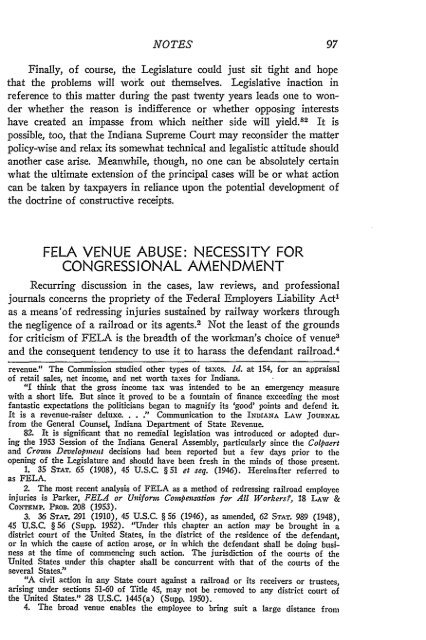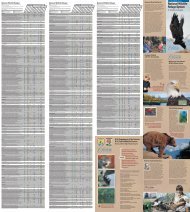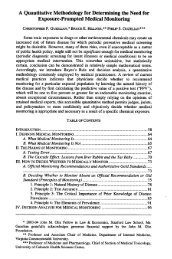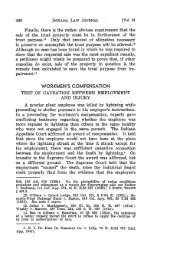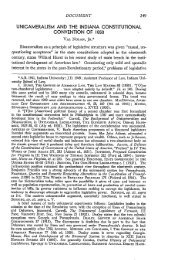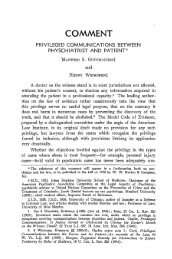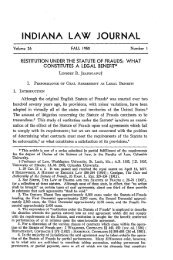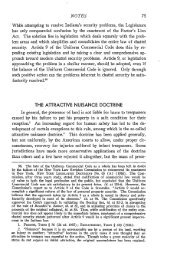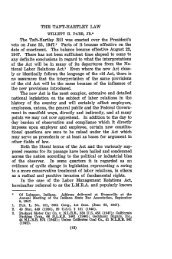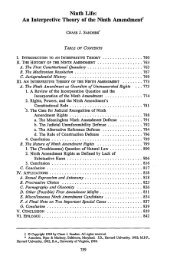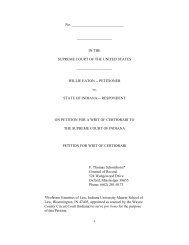fela venue abuse: necessity for congressional amendment
fela venue abuse: necessity for congressional amendment
fela venue abuse: necessity for congressional amendment
You also want an ePaper? Increase the reach of your titles
YUMPU automatically turns print PDFs into web optimized ePapers that Google loves.
NOTES<br />
Finally, of course, the Legislature could just sit tight and hope<br />
that the problems will work out themselves. Legislative inaction in<br />
reference to this matter during the past twenty years leads one to wonder<br />
whether the reason is indifference or whether opposing interests<br />
have created an impasse from which neither side will yield. 8 2 It is<br />
possible, too, that the Indiana Supreme Court may reconsider the matter<br />
policy-wise and relax its somewhat technical and legalistic attitude should<br />
another case arise. Meanwhile, though, no one can be absolutely certain<br />
what the ultimate extension of the principal cases will be or what action<br />
can be taken by taxpayers in reliance upon the potential development of<br />
the doctrine of constructive receipts.<br />
FELA VENUE ABUSE: NECESSITY FOR<br />
CONGRESSIONAL AMENDMENT<br />
Recurring discussion in the cases, law reviews, and professional<br />
journals concerns the propriety of the Federal Employers Liability Act,<br />
as a means'of redressing injuries sustained by railway workers through<br />
the negligence of a railroad or its agents. 2 Not the least of the grounds<br />
<strong>for</strong> criticism of FELA is the breadth of the workman's choice of <strong>venue</strong> 3<br />
and the consequent tendency to use it to harass the defendant railroad. 4<br />
re<strong>venue</strong>." The Commission studied other types of taxes. Id. at 154, <strong>for</strong> an appraisal<br />
of retail sales, net income, and net worth taxes <strong>for</strong> Indiana.<br />
"I think that the gross income tax was intended to be an emergency measure<br />
with a short life. But since it proved to be a fountain of finance exceeding the most<br />
fantastic expectations the politicians began to magnify its 'good' points and defend it.<br />
It is a re<strong>venue</strong>-raiser deluxe. . . ." Communication to the INDIANA LAW JOURNAL<br />
from the General Counsel, Indiana Department of State Re<strong>venue</strong>.<br />
82. It is significant that no remedial legislation was introduced or adopted during<br />
the 1953 Session of the Indiana General Assembly, particularly since the Colpaert<br />
and Crown Development decisions had been reported but a few days prior to the<br />
opening of the Legislature and should have been fresh in the minds of those present.<br />
1. 35 STAT. 65 (1908), 45 U.S.C. § 51 et seq. (1946). Hereinafter referred to<br />
as FELA.<br />
2. The most recent analysis of FELA as a method of redressing railroad employee<br />
injuries is Parker, FELA or Uni<strong>for</strong>m Compensation <strong>for</strong> All Workers?7, 18 LAW &<br />
CONTEMP. PROB. 208 (1953).<br />
3. 36 STAT. 291 (1910), 45 U.S.C. § 56 (1946), as amended, 62 STAT. 989 (1948),<br />
45 U.S.C. § 56 (Supp. 1952). "Under this chapter an action may be brought in a<br />
district court of the United States, in the district of the residence of the defendant,<br />
or in which the cause of action arose, or in which the defendant shall be doing business<br />
at the time of commencing such action. The jurisdiction of the courts of the<br />
United States under this chapter shall be concurrent with that of the courts of the<br />
several States."<br />
"A civil action in any State court against a railroad or its receivers or trustees,<br />
arising under sections 51-60 of Title 45, may not be removed to any district court of<br />
the United States." 28 U.S.C. 1445(a) (Supp. 1950).<br />
4. The broad <strong>venue</strong> enables the employee to bring suit a large distance from
INDIANA LAW JOURNAL<br />
Ineffective judicial attempts to prevent vexatious suits have lent <strong>for</strong>ce<br />
to this argument 5 and have also provoked discussion concerning amend-<br />
where the cause of action arose. In general, the railroads claim that such distant<br />
suits present a great inconvenience and expense in defending and are brought to<br />
harass and vex the railroad. The emphasized factors of inconvenience and expense<br />
are the cost of transporting, and maintaining, witnesses to the distant court; the lack<br />
of compulsory process to obtain the attendance of witnesses; prejudice through<br />
failure to have the actual presence of witnesses; the cost of obtaining depositions;<br />
the inability to view the scene of the accident when appropriate; and the damage<br />
to business due to the absence of employee witnesses. Miles v. Illinois Central R.R.,<br />
315 U.S. 698 (1942); Baltimore & Ohio R.R. v. Kepner, 314 U.S. 44 (1941); Cleveland,<br />
C., C. & St. L. Ry. v. Shelly, 96 Ind. App. 273, 170 N.E. 328 (1930); Reed's<br />
Adm'x v. Illinois Central R.R., 182 Ky. 455, 206 S.W. 794 (1918); Boston & M. R.R.<br />
v. Whitehead, 307 Mass. 106, 29 N.E.2d 916 (1940); New York, C. & St. L. R.R.<br />
v. Matzinger, 136 Ohio St. 271, 25 N.E.2d 349 (1940) (not FELA suit); Union<br />
Pacific R.R. v. Utterback, 173 Oregon 572, 146 P.2d 769 (1944), cert. denied,<br />
323 U.S. 710, 711 (1944); Chicago, M. & St. P. Ry. v. McGinley, 175 Wis. 565, 185<br />
N.W. 218 (1921). The allegation was sometimes made that these factors caused an<br />
unreasonable burden on interstate commerce. But such a claim has been generally<br />
discredited. Baltimore & Ohio R.R. v. Kepner, 314 U.S. 44, 50, 51 (1941) ; Jablonski v.<br />
Southern Pacific Co., 76 F. Supp. 1022, 1023 (S.D. N.Y. 1948).<br />
For an excellent discussion of the extent of FELA <strong>venue</strong> <strong>abuse</strong> including some<br />
dramatic statistics see Winters, Interstate Commerce in Damage Suits, 29 J. AM.<br />
Jun. Soc'y 135 (1946). In Atchison, T. & S. F. Ry. v. Andrews, 338 Ill. App. 552.<br />
88 N.E.2d 364 (1949), an attorney was enjoined from continuance of a solicitation<br />
organization located in Chicago under which he was litigating there ninety-two FELA<br />
actions with claims of approximately five million dollars. See General Orders No.<br />
18 and 18a of the Director General of Railroads issued in 1918 to limit <strong>venue</strong> in<br />
tort actions against railroads to prevent "remote" suits which seriously interfere with<br />
the physical operation of the railroads. The Orders are set out in a footnote to a<br />
sustaining decision in Alabama & Vicksburg Ry. v. Journey, 257 U.S. 111 (1921).<br />
The query of why a distant suit is brought hundreds of miles from the scene<br />
of the azcident or the employee's residence may be answered by realistic considerations.<br />
When an employee is injured it is inconceivable that a distant court is sought<br />
<strong>for</strong> substantive-procedural advantages. Reed's Adm'x v. Illinois Central R.R., 182<br />
Ky. 455, 206 S.W. 794 (1918) (the court assumes that one court would do justice<br />
and give a fair trial as well as another). On the other hand, it is very conceivable<br />
that a claimant and his attorney are aware that awards of metropolitan juries are<br />
higher than those of rural juries, see Winters, supra, at 136, or that there is a greater<br />
bargaining power <strong>for</strong> the client if the distant suit will be of such a great expense<br />
to the defendant that it is to the railroad's interest to settle, even <strong>for</strong> an amount<br />
greater than the actual injury suffered. "When the chasers solicited cases . . . they<br />
pointed out to the injured employees that it would be difficult and expensive <strong>for</strong> the<br />
railroads to bring . . . witnesses to Chicago <strong>for</strong> the trial and that there<strong>for</strong>e the railroad<br />
companies were more likely to make settlements, and that . . . in Chicago larger<br />
verdicts could be obtained there than in the states where the accidents occurred."<br />
Atchison, T. & S. F. Ry. v. Andrews, 338 Ill. App. 552, 566, 88 N.E.2d 364, 370, 371<br />
(1949). See Reed's Adm'x v. Illinois Central R.R., supra, at 468, 469, 206 S.W.<br />
at 800; Chicago, M., St. P. & P. Ry. v. Wolf, 199 Wis. 278, 226 N.W. 297 (1929)<br />
(a well organized solicitation business was described).<br />
5. Pope v. Atlantic Coast Line R.R., 73 Sup. Ct. 749 (1953) ; Mo. ex rel.<br />
So. Ry. v. Mayfield, 340 U.S. 1 (1950); Miles v. Illinois Central R.R., 315 U.S. 698<br />
(1942); Baltimore & Ohio R.R. v. Kepner, 314 U.S. 44 (1941).<br />
One judicial remedy <strong>for</strong> the vexatious suit is a restraining order against prosecution<br />
of the distant suit issued by the court having jurisdiction over the employee.<br />
See Note, When Courts of Equity Will Enjoin Foreign Suits, 27 IOWA L. REv. 76<br />
(1941); Helsell, Injunctive Relief Against Oppressive Suits in Foreign Jurisdictions,<br />
12 F.R.D. 502 (1952); McCLINTOCK, EQuITY 462 (2d ed. 1948). The innumerable
NOTES<br />
ment to the FELA <strong>venue</strong> section. Review of past decisions sheds some<br />
light on the direction future action may take.<br />
Chronologically, the present ineffectiveness of equitable methods<br />
<strong>for</strong> preventing vexatious litigation derives from Miles v. Ill. Cent. R.R., 6<br />
decided in 1942. The Supreme Court struck down an attempt by a<br />
Tennessee state court to enjoin prosecution of an FELA suit in a Missouri<br />
court; dicta in Mr. Justice Reed's majority opinion created later<br />
confusion by declaring that the Missouri court must hear the suit as<br />
presented originally. 7 That same year a similar attempt by a state court<br />
fact situations arising make it difficult to <strong>for</strong>mulate precisely what elements constitute<br />
a vexatious or harassing suit. Ex parte Crandall, 53 F.2d 969 (7th Cir. 1931),<br />
cert. denied, 285 U.S. 540 (1932) (petition denied <strong>for</strong> habeas corpus by imprisoned<br />
employee <strong>for</strong> violation of state court decree enjoining prosecution of FELA action<br />
in another state court); Alspaugh v. N. Y., S. & St. L. R.R., 98 Ind. App. 280, 188<br />
N.E. 869 (1934); Cleveland, C., C. & St. L. Ry. v. Shelly, 96 Ind. App. 273, 170<br />
N.E. 328 (1930); Bankers' Life Co. v. Loring, 217 Iowa 534, 250 N.W. 8 (1933)<br />
(intent to coerce a settlement is sufficient grounds to enjoin distant suit; not FELA<br />
case) ; Reed's Adm'x v. Illinois Central R.M, 182 Ky. 455, 206 S.W. 794 (1918)<br />
(leading case on state court enjoining FELA action in a distant state court) ; Missouri<br />
Pacific Ry. v. Harden, 158 La. 889, 105 So. 2 (1925) (difference between procedure<br />
and practice is not sufficient to enjoin); Boston & M. MR. v. Whitehead, 307 Mass.<br />
106, 108, 29 N.E.2d 916, 917, 918 (1940) (hope <strong>for</strong> a larger verdict is not alone<br />
harassing); Southern Pacific Co. v. Baum, 39 N.M. 22, 38 P.2d 1106 (1934) (mere<br />
inconvenience is not grounds <strong>for</strong> an injunction); Louisville & N. RR. v. Ragan,<br />
172 Tenn. 593, 113 S.W.2d 743 (1938); see also 56 YALE L. J. 1234, 1236 (1947).<br />
The other judicial remedy <strong>for</strong> the harassing suit is dismissal by the initial court<br />
trying the cause under the doctrine of <strong>for</strong>um non conveniens. The doctrine has been<br />
classically stated as "the discretionary power of a court to decline to exercise a<br />
possessed jurisdiction whenever it appears that the cause be<strong>for</strong>e it may be more<br />
appropriately tried elsewhere." Blair, The Doctrine of Forum Non Conveniens in<br />
Anglo-American Law, 29 CoL. L. REv. 1 (1929). Barrett, The Doctrine of Forum<br />
Non Conveniens, 35 CALIF. L. Rnv. 380 (1947). The cases indicate no distinction<br />
in the allegations and considerations <strong>for</strong> ruling on <strong>for</strong>um iwn conveniens or in granting<br />
an injunction. The better view, instead of a mechanical <strong>for</strong>mula <strong>for</strong> <strong>for</strong>um non<br />
conveniens or a restraining order, would be to balance the advantages and disadvantages<br />
of the distant suit to the litigants and require a clear showing of real injury<br />
which approaches evidence of intent by the plaintiff employee to defraud, harass,<br />
and vex the defendant. See Southern Pacific Co. v. Baum, 39 N.M. 22, 38 P.2d<br />
1106 (1934). In denying the railroad an injunction that court said something more<br />
substantial than a mere showing of inconvenience and expense was required. The<br />
implication is that such a showing of hardship is needed as to draw an inference<br />
of iftent to secure some inequitable advantage by the employee. In this case the<br />
employee presented a good faith purpose in his <strong>venue</strong> choice; the court appears to<br />
grasp the correlation between the function of the courts and the purpose of FELA<br />
<strong>venue</strong>. Although a justification of choice of <strong>venue</strong> is presumed and should not be<br />
required in the first instance, it should be required to rebut a clear showing by the<br />
railroad of hardship and harassment in the <strong>venue</strong> selected.<br />
Since 1404(a), infra note 9, the federal courts are adequately equipped to prevent<br />
FELA <strong>venue</strong> <strong>abuse</strong>. There<strong>for</strong>e, the scope of this note will be restricted to FELA<br />
<strong>venue</strong> in the state courts.<br />
6. 315 U.S. 698 (1942).<br />
7. "The Missouri courts here involved must permit this litigation." Supra note<br />
6, at 704. The Court continues: "To deny citizens from other states, suitors under<br />
F.E.L.A., access to its [Missouri] courts would, if it permitted access to its own<br />
citizens, violate the Privileges and Immunities Clause." Ibid. These statements could
INDIANA LAW JOURNAL<br />
to enjoin litigation in a federal court was invalidated in B. & 0. R.R.<br />
v. Kepner. 8 Since the vexatious suit could not be <strong>for</strong>eclosed in a federal<br />
court by injunction, Congress, in 1948, enacted Section 1404(a) of<br />
the Judicial Code to empower the federal district courts to transfer<br />
any civil action in the interest of justice and <strong>for</strong> the convenience of<br />
the parties;9 thus, the equitable power of <strong>for</strong>um non conveniens was<br />
statutorily conferred upon federal courts. It now became of immediate<br />
interest whether state courts would also be permitted, in view of the<br />
equitable policy of 1404(a) and of the Miles dicta, to utilize the doctrine<br />
of <strong>for</strong>um non conveniens to dismiss inconvenient suits.<br />
Mr. Justice Frankfurter in Missouri v. Mayfield' ° expressly stated<br />
that state courts could adopt or reject the doctrine of <strong>for</strong>um non conveniens<br />
according to their own procedural rules or policy. Neither the<br />
Miles case nor federal law prevented the state <strong>for</strong>um from dismissing<br />
an FELA suit if such was the operation of local law with regard to<br />
other actions. Nothing prior to 1404(a) purported to <strong>for</strong>ce states to<br />
entertain FELA actions. 11 Mr. Justice Jackson, concurring, expressed<br />
the more reasonable conclusion that 1404(a) evidences <strong>congressional</strong><br />
be interpreted as stating an unquestionable fact as regards Missouri practice and not<br />
a general dicta holding that FELA <strong>venue</strong> is compulsory on state courts, <strong>for</strong> Missouri<br />
courts had interpreted their statute law as compelling jurisdiction over all<br />
transitory actions, see Bright v. Wheelock, 323 Mo. 840, 873, 20 S.W.2d 684, 699<br />
(1929) ; thus to refuse this present suit by a citizen of another state would have been<br />
a violation of the "privileges and immunities" clause. The dicta when taken in context<br />
with the opinion, including a statement that the power of Missouri to regulate<br />
its courts was not an issue, should have precluded any reliance upon it.<br />
However, the dicta was relied upon. The Miles case was held to be "completely<br />
decisive" that a state court must hear an FELA action. Leet v. Union Pacific R.R.,<br />
25 Cal.2d 605, 155 P.2d 42 (1944), cert. denied, 325 U.S. 866 (1945). See also Gulf<br />
Oil Corp. v. Gilbert, 330 U.S. 501, 505 (1947).<br />
8. 314 U.S. 44 (1941).<br />
9. 28 U.S.C. 1404(a) (Supp. 1950). "For the convenience of parties and witnesses,<br />
in the interest of justice, a district court may transfer any civil action to any other<br />
district or division where it might have been brought." See Harris, Survey of the<br />
Federal Judicial Code, 3 SOUTHWESTERN L. J. 229, 235 (1949); 18 J. B. A. KAN. 242<br />
(1949). Note that this differs from common law <strong>for</strong>umo non conveniens which resulted<br />
in dismissal of the action. However, this section is generally referred to as a statutory<br />
enactment of the doctrine.<br />
The FELA <strong>venue</strong> section is subject to a motion to transfer under 1404(a) in<br />
the federal courts. Ex parte Collett, 337 U.S. 55 (1949). The court concluded that<br />
the broad language of 1404(a) and the evidences of <strong>congressional</strong> intent, especially<br />
the revisor's notes, infra note 16, could lead only to the conclusion that a special <strong>venue</strong><br />
section as in FELA was subject to 1404(a) in federal courts.<br />
10. 340 U.S. 1 (1950). In an FELA action in a Missouri state court, a motion<br />
of <strong>for</strong>um non conveniens was denied. The defendant railroad instituted proceedings<br />
in the state supreme court <strong>for</strong> a writ of mandamus to compel the trial court to entertain<br />
the motion; the writ was denied.<br />
11. Mr. Justice Frankfurter apparently continued the view he held in dissenting<br />
in the Miles case. The <strong>venue</strong> section of FELA does not remove state courts' powers<br />
to subject it to equitable considerations whether by injunction or <strong>for</strong>um non conveniens.
NOTES<br />
intent to subject FELA <strong>venue</strong> to equitable considerations and to remove<br />
the compulsion of the Miles dicta on state courts. 12<br />
Although state utilization of <strong>for</strong>um non conveniens was not<br />
grounded upon the passage of 1404(a), the question remained unanswered<br />
as to whether the states could, upon the theory that 1404(a)<br />
abolished the rule of the Miles case, employ the injunction to prevent<br />
harassing FELA suits in other jurisdictions. Since very few state courts<br />
had, nor have, adopted <strong>for</strong>um non conveniens as local policy, the issue<br />
was acute.1 3 It was against this background that, in the 1952-53 term, the<br />
Supreme Court decided Pope v. Atlantic Coast Line R.R. 4<br />
The respondent railroad sought an injunction in a Georgia court<br />
to restrain a Georgia citizen from bringing his FELA suit in an Alabama<br />
court. The cause of action arose in Georgia. The trial court refused<br />
to grant the injunction but the Supreme Court of Georgia reversed,<br />
holding that state courts could, after the adoption of 1404(a), enjoin<br />
the continuance of an FELA suit in another state court. The Supreme<br />
Court of the United States reversed, finding that the Miles case still controlled.<br />
Mr. Chief Justice Vinson, <strong>for</strong> the majority, construed 1404(a)<br />
literally; it conferred <strong>for</strong>um non conveniens upon federal courts alone.<br />
"Nor does 1404(a) contemplate the collateral attack on <strong>venue</strong> . . .; it<br />
contains no suggestion that the <strong>venue</strong> question may be raised and settled<br />
by the initiation of a second lawsuit in a court in a <strong>for</strong>eign jurisdiction.<br />
. ...15<br />
Mr. Justice Frankfurter, dissenting, broadly interpreted 1404(a)<br />
as a declaration of <strong>congressional</strong> policy to subject FELA <strong>venue</strong> to<br />
equitable considerations and thus to state restraining orders. 16 The Miles<br />
decision was no longer controlling. because he thought it unreasonably<br />
narrow to believe that Congress intended merely to prevent <strong>abuse</strong> of<br />
12. 340 U.S. 1, 5, 6 (1950).<br />
13. Barely half a dozen states have accepted the doctrine. Barrett, supra note 5.<br />
at 388, 389.<br />
14. 73 Sup. Ct. 749 (1953). The state supreme court opinion is reported in 209<br />
Ga. 187, 71 S.E.2d 243 (1952). See 26 So. CAni. L. Rzv. 210 (1953). In Atlantic<br />
Coast Line R.R. v. Wood, 58 So.2d 549 (Fla. 1952), the Florida Supreme Court in<br />
a similar fact situation held that Miles still controlled despite 1404(a). The court<br />
utilized reasoning similar to that of the majority opinion in the United States Supreme<br />
Court.<br />
15. 73 Sup. Ct. 749, 752 (1953).<br />
16. 73 Sup. Ct. 749, 753-757 (1953).<br />
See revisor's notes to 28 U.S.C.A. 1404(a) (1948). H. R. REP. 308, 80th Cong.,<br />
1st Sess. (1947). "Subsection (a) was drafted in accordance with the doctrine of<br />
<strong>for</strong>um non conveniens, permitting transfer to a more convenient <strong>for</strong>um, even though the<br />
<strong>venue</strong> is proper. As an example of the need of such a provision, see Baltimore & Ohio<br />
R.R. v. Kepner which was prosecuted under the F.E.L.A. in New York, although the<br />
accident occurred and the employee resided in Ohio." See the Supreme Court's<br />
interpretation of <strong>congressional</strong> intent in Ex parte Collett, 337 U.S. 55 (1949).
INDIANA LAW JOURNAL<br />
FELA <strong>venue</strong> in federal courts while ignoring the same considerations<br />
in state courts. Admittedly the case illustrated the effect of a literal<br />
interpretation of 1404(a), because Alabama, where the employee initiated<br />
his action, did not recognize the doctrine of <strong>for</strong>um non conveniens,<br />
so that the railroad's sole remedy against the alleged vexatious choice of<br />
<strong>for</strong>um was an injunction. 17 It follows that adherence to the rule of<br />
the Miles case creates a haven <strong>for</strong> employee suits in those state courts<br />
which do not recognize the inconvenient <strong>for</strong>um doctrine. Moreover,<br />
Mr. Justice Frankfurter asserts, denial of the injunctive process destroys<br />
between state and federal courts and between different state courts<br />
the uni<strong>for</strong>mity of treatment generally accorded FELA litigants. Underlying<br />
these views appears to be the conviction that <strong>for</strong>um non conveniens<br />
and enjoining an FELA litigant are indistinguishable as equitable powers<br />
of state courts which in the first instance were not destroyed by the<br />
FELA <strong>venue</strong> section: "It is beside the point to urge that 1404(a)<br />
speaks only of <strong>for</strong>um non conveniens in federal courts and not of state<br />
court injunctions against out of state suits." 18<br />
In recognition that the harassing suit presents a distinct problem<br />
in FELA litigation, little assistance could be expected from the Pope<br />
case no matter what decision was reached. Manifestly, to relegate the<br />
railroad to the sole use of the inconvenient <strong>for</strong>um doctrine as the chief<br />
attack upon the vexatious suit is an insignificant aid in resolving the<br />
problem. Very few states have adopted the use of the doctrine and the<br />
breadth of the <strong>venue</strong> section permits easy access to other states' courts.<br />
On the other hand, the alternative decision in the Pope case, affirming<br />
the use of the injunction, is also subject to serious objection. To<br />
impress FELA litigants of the equitable limitation upon their choice<br />
of <strong>venue</strong>, the railroads quite conceivably might seek restraining orders<br />
when any suit was brought in a distant court not completely satisfactory<br />
to the railroad. An appeal in case the injunction were denied would<br />
have rested on the belief that it should be public knowledge that the<br />
restraining order would be used to full avail and no unsatisfactory <strong>venue</strong><br />
tolerated. The employee would then be burdened not only with the<br />
expense of contesting the appeal but also with a great delay in time.<br />
Obviously, the typical FELA litigant is financially incapable of bearing<br />
the cost and delay of prolonged proceedings be<strong>for</strong>e final adjudication<br />
of his claim on the merits. 9 As a result of this strengthening factor<br />
17. See Pope v. Atlantic Coast Line R.R., 73 Sup. Ct. 749, 756 (1953). See<br />
Atlantic Coast Line R.R. v. Pope, 209 Ga. 187, _, 71 S.E.2d 243, 248 (1952).<br />
18. 73 Sup. Ct. 749, 755 (1953).<br />
19. Mr. Justice Jackson concurring in the Miles case, 315 U.S. 698, 705, makes<br />
an often stated observation that: "He [the employee] is not given a remedy, but only
NOTES<br />
in its bargaining position, the railroads would then be in a position to<br />
coerce an unreasonable settlement. Moreover, even though an employee<br />
may have a bona fide reason <strong>for</strong> bringing suit where the defendant is<br />
merely doing business, though the cause of action may have arisen elsewhere,<br />
the threat of a time-consuming, expensive series of legal proceedings<br />
might very possibly induce him to sue in a <strong>for</strong>um more acceptable<br />
to the defendant. The plaintiff's election of a <strong>for</strong>um could be<br />
effectively restricted through eliminating the effect of the "doing business"<br />
choice, but as a consequence, the essence of the <strong>venue</strong> section 20<br />
would be undermined.<br />
In addition, the efficacy of the injunction is conditional. The party<br />
enjoined could refuse to comply with the order but escape contempt<br />
proceedings by leaving the jurisdiction of the enjoining court. 2 1 Yet<br />
a more important determinative of the injunction's ineffectiveness is<br />
the recognition given to it by the court where the suit was initiated. No<br />
substantial authority exists to require recognition under the full faith<br />
and credit clause. 22 The strongest argument advanced by those state<br />
courts which refuse recognition of the decree is that recognition and<br />
consequent dismissal of the suit would be such a denial of its courts to<br />
citizens of other states as to constitute discrimination which violates<br />
the privileges and immunities clause of the United States Constitution. 23<br />
In view of Douglas v. New York, N. H. & H. R.R., 2 4 where dismissal<br />
a lawsuit ... [I]n most cases he Will be unable to pursue that except by splitting<br />
his speculative prospects with a lawyer. The functioning of this backward system<br />
of dealing with industrial accidents . . . [results in] two dollars of judgment <strong>for</strong><br />
every dollar that actually reaches those who have been damaged. . . . It seems more<br />
probable that Congress intended to give the disadvantaged workman some leverage<br />
in the choice of <strong>venue</strong> than that it intended .. . [that] the railroad could <strong>for</strong>ce him<br />
to try one lawsuit at home to find out whether he would be allowed to try his principal<br />
lawsuit elsewhere." Id. at 707, 708.<br />
20. The Court discussed the history and purpose of the present FELA <strong>venue</strong><br />
section in Baltimore & Ohio R.1. v. Kepner, 314 U.S. 44, 49, 50 (1941).<br />
21. One state court, recognizing the FELA claimant's attempt to circumvent<br />
its injunction against the distant suit, enjoined within its jurisdiction the notary,<br />
the claimant's attorney, and the witnesses from taking testimony and certifying to<br />
any deposition in any manner representing the restrained party in the distant suit.<br />
New York, C. & St. L. R.R. v. Perdiue, 97 Ind. App. 517, 187 N.E. 349 (1933).<br />
22. MCCLINTOCK, EQUITY 477 (2d ed. 1948); STUMBEEG, CoNFLICT oF LAWS<br />
123 (1950); Foster, Place of Trial in Civil Actions, 43 H~av. L. REV. 1217, 124'<br />
(1930); 21 NEB. L. Rv. 160 (1942); 39 YALE L. J. 719 (1930).<br />
23. Although there are few cases on this specific issue, the leading case appears<br />
to be State ex rel. Bossung v. District Ct., 140 Minn. 494, 498, 168 N.W. 589, 591<br />
(1918).<br />
24. 279 U.S. 377 (1929). A state statute conferred discretionary power on state<br />
courts to dismiss transitory actions. Although the opinion made no specific mention<br />
of <strong>for</strong>um non conveniens, the case has been generally accepted as authority <strong>for</strong> state<br />
court exercise of the doctrine. The test laid down, dismissal on basis of "residence"<br />
does not violate the "privileges and immunities" clause, has been used by state courts
104 INDIANA LAW JOURNAL<br />
was permitted under a statute based upon plaintiff's residence rather<br />
than his citizenship, and the decision in the Mayfield case, 25 such an<br />
interpretation is unnecessarily restricted. For example, if a citizen of<br />
state X sued in the courts of X but resided in state Y where the injunction<br />
issued, state X could deny use of its courts in recognition of the<br />
injunction; since the state could refuse access to its courts in the interest<br />
of justice to its own citizens, no discrimination would result from according<br />
similar treatment to citizens of other states. Despite the fact that<br />
the privileges and immunities contention is weak, the present law with<br />
respect to recognition of <strong>for</strong>eign decrees is vague and depends upon<br />
perennial issues of comity between the states. 26<br />
'Since permitting use of the injunction could potentially have caused<br />
more harm than good, 27 and because of nonrecognition by a majority<br />
of state courts of the <strong>for</strong>um non. conveniens doctrine, it is manifest<br />
that the Pope case neither furnished, nor could it have furnished, any<br />
substantial assistance in this problem area. Although the Pope case permits<br />
this obvious conclusion, it does not so patently indicate the next<br />
step in the legal battle over <strong>abuse</strong> of FELA <strong>venue</strong>.<br />
If the judiciary is to provide relief from inequitable use of the<br />
<strong>venue</strong> section, clearly the inconvenient <strong>for</strong>um doctrine must provide<br />
the means. 28 In light of the states' inertia, only a more decisive position<br />
to determine the limit of their dismissal powers in FELA cases. Perhaps more<br />
emphasis upon dismissal in the interest of justice could have been noted. This decision<br />
<strong>for</strong>med the basis <strong>for</strong> the unnecessary confusion after the Miles case dicta.<br />
25. The Mayfield case enumerates grounds upon which access to a state court<br />
may be denied. The state court opinion was ambiguous as to just what grounds the<br />
decision was based upon. The majority of the Supreme Court deemed it necessary,<br />
on the probability that the state court felt bound by federal case law, to enunciate<br />
clearly the status of <strong>for</strong>um non conveniens in state courts as regards FELA. The opinion<br />
established the grounds upon which a state could dismiss an FELA action without<br />
involving a federal question-local procedural policy applicable to all actions including<br />
those of nonresident citizens of the state. The constitutional test of the Douglas<br />
case was utilized by the Court. "[N]o substantial question as to the constitutional<br />
validity of the court's action would appear since the application of the doctrine<br />
[<strong>for</strong>um non convemients] would depend on other factors than the mere residence or<br />
citizenship of the parties." Barrett, supra note 5, at 393.<br />
26. See note 22 supra.<br />
27. Adoption of the injunctive device would also have been in conflict with the<br />
principle of uni<strong>for</strong>mity and created even more confusion as to the rights of the<br />
litigants under FELA <strong>venue</strong>. E.g., federal courts use <strong>for</strong>um non conveniens, some<br />
state courts use <strong>for</strong>um non conveniens, and in the remaining state courts the injunctive<br />
device would have been used.<br />
28. "The difficulty both in obtaining and en<strong>for</strong>cing the injunction makes it appear<br />
a rather inadequate makeshift, of some use in correcting certain of the more extreme<br />
[<strong>venue</strong>] <strong>abuse</strong>s. . . . The chief significance [of restraining decrees against distant<br />
suits] . . . is to indicate the need of meeting the issue directly by staying or dismissing<br />
pending actions whenever another <strong>for</strong>um is more appropriate." Foster, supra<br />
note 22, at 1248.
NOTES<br />
by the Supreme Court would seemingly resolve the problem. A plausible<br />
legal argument may be proposed which supports a requirement that<br />
state courts entertaining FELA suits must hear a motion of <strong>for</strong>um non<br />
conveniens. Uni<strong>for</strong>m treatment of litigants in federal and state courts<br />
has long been a strong influence upon the development of FELA law. 29<br />
Arguably, if 1404(a) permits transfer of inconvenient FELA suits in<br />
federal courts, then uni<strong>for</strong>mity requires that state courts also assert<br />
the power to dismiss on the grounds of <strong>for</strong>um non conveniens. Certainly<br />
it is true, as Mr. Justice Frankfurter emphasized, that refusal<br />
to permit use of the injunction achieves the opposite of uni<strong>for</strong>m treatment<br />
since <strong>venue</strong> is thereby absolute in all state courts except those<br />
i-ecognizing the <strong>for</strong>um non conveniens doctrine. 30 Obviously, requiring<br />
state courts to consider a motion <strong>for</strong> <strong>for</strong>um non conveniens would be<br />
an alteration in procedure <strong>for</strong> most states, but this has not been an<br />
insurmountable objection in the past development of FELA law. 31 Moreover,<br />
compulsory adoption of the doctrine would place much less burden<br />
on state courts than have other changes wrought by FELA, <strong>for</strong> <strong>for</strong>um<br />
non conveniens would permit states to refuse to exercise jurisdiction. 32<br />
This is no small consideration since it is estimated that two-thirds of<br />
all FELA suits are brought in state courts. 33 Other than the assertion<br />
29. Dice v. Akron, Canton & Youngstown R.R., 342 U.S. 359 (1952) (Ohio<br />
state courts must submit all factual issues under FELA to the jury regardless of<br />
state procedure to the contrary). That Court said: ". . . [Olnly if federal law controls<br />
can the federal Act be given that uni<strong>for</strong>m application throughout the country<br />
essential to effectuate its purposes." Id. at 361. Brown v. Western Ry. of Ala., 338<br />
U.S. 294 (1949) (a state court could not invoke local rules of pleading burdening<br />
rights under FELA); Davis v. Wechsler, 263 U.S. 22 (1923); C. & 0. Ry. v. Kelly,<br />
241 U.S. 485 (1916) (state court's instructions on measure of damages invalid as<br />
in conflict with federal court principles under FELA). See <strong>for</strong> a general discussion<br />
and the suggested standard to determine when state procedural rules must give way<br />
to federal rules in FELA, 27 IND. L. J. 536 (1952).<br />
30. This deduction must be premised on the assumption that <strong>for</strong>umn non conveniens<br />
and the injunction subject <strong>venue</strong> to uni<strong>for</strong>m equitable considerations. But<br />
this is not a sound assumption, <strong>for</strong> the devices are two distinct remedies with inherent<br />
differences requiring separate considerations even though the same end result may<br />
be speciously reached. Use of the remedies interchangeably would not, when broadly<br />
considered, achieve true uni<strong>for</strong>mity in FELA <strong>venue</strong>. There is a considerable difference<br />
in expense and convenience between deciding the propriety of <strong>venue</strong> in the same<br />
court litigating the merits of the cause of action and a separate court in another state.<br />
The injunction could be litigated again in substance by the distant court on the question<br />
of recognition; if in addition, the injunction had been appealed in the enjoining<br />
court several suits would be required be<strong>for</strong>e litigation on the merits. A decision on<br />
<strong>for</strong>um non conveniens would be finally decided, even after review, in the courts of<br />
one state with unconditioned effect. It cannot be reasonably denied that a large distinction<br />
with substantial effects exists between <strong>for</strong>um non conveniens and an injunction.<br />
31. See note 29 supra.<br />
32. See 46 ILL. L. K'v. 115, 126 n.51 (1951). While such a result would <strong>for</strong>ce<br />
state courts to entertain dual procedures, the concurrent jurisdiction area is familiar<br />
with such duality. See <strong>for</strong> a brief illustration with cases cited, id. at 127 n.54.<br />
33. See 46 ILL. L. REv. 115, 128 n.58 (1951).
INDIANA LAW JOURNAL<br />
of a doctrinaire states' rights position, there<strong>for</strong>e, little objection could<br />
be made by defenders of local law.<br />
Despite the superficial appeal of that argument, serious doubt<br />
arises whether the question could be presented to the Court at all. If<br />
the defendant in the Pope case had moved <strong>for</strong> dismissal by the Alabama<br />
court on the basis of <strong>for</strong>um non conveniens, the motion would no doubt<br />
have been denied and this result affirmed by the Alabama Supreme Court<br />
in reliance upon local law. 34 Presumably the Mayfield case is substantial<br />
authority <strong>for</strong> this position since Mr. Justice Frankfurter there stated<br />
that a state court may refuse to accept a motion <strong>for</strong> <strong>for</strong>wom non conveniens<br />
on the grounds of local procedural rules or local policy. 3 5 The<br />
complete absence of any suggestion in Mayfield that a state must accept<br />
the doctrine does not auger well <strong>for</strong> such a future contention. It does<br />
not even appear that petitioner's counsel advanced this proposition. The<br />
dissenters in the Mayfield case thought a federal question was involved<br />
but only on the basis that the Missouri Supreme Court correctly concluded<br />
that <strong>for</strong> the trial court to entertain the motion <strong>for</strong> <strong>for</strong>umn non<br />
conveniens would violate the privileges and immunities clause. 36 This<br />
is, indeed, a far cry from a belief that the Missouri courts must entertain<br />
the motion because federal law required it. There<strong>for</strong>e, had the<br />
Alabama court denied <strong>for</strong>um non conveniens expressly and solely on<br />
considerations of state law, it is highly doubtful that the desiderata of<br />
uni<strong>for</strong>mity in the adjudication of FELA cases would be sufficient to<br />
elevate the denial to the status of a federal question so that Supreme<br />
Court review could be obtained.<br />
Should such a case reach the Supreme Court the probability of a<br />
compulsory inconvenient <strong>for</strong>um doctrine is also slight in view of the<br />
restricted interpretation of 1404(a) enunciated by the Supreme Court<br />
in the Pope case. Moreover, a judicial pronouncement imposing the<br />
doctrine on state courts encounters serious policy objections. The majority<br />
of state courts would suddenly be vested with an unfamiliar power<br />
the use of which would be guided only by federal decisions on 1404(a)<br />
and by <strong>for</strong>eign state decisions on <strong>for</strong>um non conveniens and injunctions..<br />
The relevant criteria by which to judge a vexatious suit are dis-<br />
34. See note 17 supra.<br />
35. The Supreme Court reviewed on the grounds that the state supreme court<br />
felt bound by federal case law to deny <strong>for</strong>um non conveniens in FELA suits. The<br />
majority decided, upon this basis, that the federal cases did not deny this power to<br />
state courts and within constitutional limits as first enunciated in the Douglas case,<br />
279 U.S. 377, <strong>for</strong>um non conveniens could be invoked.<br />
For a brief discussion of the granting of certiorari in this case, see 46 kt. L.<br />
REv. 115, 116 n.5, 6.<br />
36. 340 U.S. 1, 6 (1950).
NOTES<br />
persed with little uni<strong>for</strong>mity among innumerably divergent fact situations.<br />
37 The opportunity <strong>for</strong> the railroads to take advantage of the new<br />
problem presented to state courts should not be underestimated. If a<br />
parallel may be drawn from other FELA problem areas, several years<br />
would elapse be<strong>for</strong>e sufficient <strong>for</strong>um non conveniens cases were presented<br />
to the Court to enable it to elaborate a clear cut expression of<br />
policy and of uni<strong>for</strong>m considerations <strong>for</strong> trial courts to apply in ruling<br />
on a motion to dismiss. 38 In the meantime the railroads could well af<strong>for</strong>d<br />
to appeal a refusal to dismiss as a warning to future litigants who may<br />
choose an inconvenient <strong>for</strong>um. The result would be that the actual delay<br />
and increased costs, or threat thereof, in defending an appeal of a refusal<br />
to dismiss coupled with a lack of uni<strong>for</strong>mity and specificity in enumerating<br />
grounds <strong>for</strong> finding the <strong>for</strong>um inconvenient, could lead the more<br />
cautious attorney and litigant to refrain from choosing a <strong>for</strong>um which<br />
possibly would be thought unsuitable to the railroad. Thus the indecisiveness<br />
of a Supreme Court decision compelling states to use <strong>for</strong>um<br />
non conveniens in FELA cases could conceivably be employed as a<br />
weapon by defendant railroads. 39<br />
In light of these considerations the sole significant result of the<br />
Pope case is the emphatic notice it gives to Congress to amend Section 6<br />
of FELA. Obviously, a satisfactory solution to the problem will not<br />
be <strong>for</strong>thcoming from the courts. But, Congressional endeavors to limit<br />
the scope of <strong>venue</strong> in an FELA suit must take cognizance of limitations<br />
inherent in the basic purpose underlying the Act. The employee must<br />
continue to be permitted easy access to state courts, yet Congress must<br />
also prevent the possibility of an unjustified and inequitable burden upon<br />
37. In Gulf Oil Corp. v. Gilbert, 330 U.S. 501, 516 (1947), the dissent of Mr.<br />
Justice Black expresses concern over the uncertainty which <strong>for</strong>um non conveniens<br />
would place upon selecting a court: "The broad and indefinite discretion left to<br />
federal courts to decide the question of convenience from the welter of factors which<br />
are relevant to such a judgment, will inevitably produce a complex of close and<br />
indistinguishable decisions from which accurate prediction of the proper <strong>for</strong>um will<br />
become difficult, if not impossible." See Barrett, supra note 5, at 402.<br />
38. See <strong>for</strong> example Alderman, What the New Suprenme Court Has Done to<br />
the Old Law of Negligence, 18 LAW & CONTEMP. PROB. 110 (1953). A chronological<br />
study is made of Supreme Court decisions upon negligence principles in FELA litigation;<br />
the decisions have resulted in considerable confusion in lower courts.<br />
39. "[C]ourts must take care to see that the ef<strong>for</strong>t to minimize hardship to the<br />
defendant does not result in imposing new and unreasonable burdens on the plaintiff.<br />
Delay, particularly in personal injury actions, favors the defendant." Barrett, supra<br />
note 5, at 420, 421.<br />
The dissenting opinion in the Mayfield case, 340 U.S. 1, 6, 7, takes cognizance<br />
of the un<strong>for</strong>tunate delay of review of <strong>for</strong>um iwtn conveniens: "The cases out of<br />
which this proceeding arises are now in their third year in the courts without coming<br />
to trial, and remand by this Court will unnecessarily cause further delay and expense<br />
in bringing them to final adjudication." Id. at 7.
INDIANA LAW JOURNAL<br />
the employer. This suggests that a rigid, narrowly defined choice of<br />
<strong>venue</strong> which neither permits easy access to the courts nor recognizes<br />
the divergent individual needs would not be satisfactory. Illustrative<br />
of this was a proposed <strong>amendment</strong> limiting <strong>venue</strong> in any tort action <strong>for</strong><br />
personal injuries or death against railroads to the place where the cause<br />
of action arose or where the plaintiff resides. 40 If process could not<br />
be acquired against the railroad, then suit could be initiated where the defendant<br />
was doing business. Such a narrow provision would, <strong>for</strong><br />
example, prevent an employee from suing in a state in which he was<br />
hospitalized and in which his medical witnesses resided if he lived, and<br />
the accident occurred, in another state. 41 A plaintiff would be similarly<br />
inhibited if available <strong>for</strong>ums' dockets were so relatively crowded as to<br />
cause unreasonable delay in litigating his claim-suit in another <strong>for</strong>um<br />
would be impossible even though of great advantage to the employee<br />
and not an inequitable and vexatious burden upon the defendant. 42 An<br />
appropriate <strong>venue</strong> section should be characterized by a flexibility which<br />
does not so limit the employee's election of <strong>for</strong>ums.<br />
Careful consideration of these factors indicates that amending the<br />
present <strong>venue</strong> section to condition the grant of state court jurisdiction<br />
upon cognizance of a timely motion <strong>for</strong> <strong>for</strong>um non conveniens would<br />
adequately alleviate the problem. Incorporating the doctrine as a substantive<br />
part of the FELA would assure the employee his choice of<br />
<strong>for</strong>um but would provide a discretionary check on the propriety of suit<br />
in a particular state court. 43 In order to adequately in<strong>for</strong>m state courts<br />
of the criteria by which <strong>for</strong>um non conveniens is to be measured, these<br />
should be enumerated in the amended section. 44 Much of the objection<br />
40. H. R. 1639, 80th Cong., 1st Sess. (1947).<br />
41. See Devitt, Venue of Actions, 34 A. B. A. J. 454 (1948). The article criticizes<br />
limitation of FELA <strong>venue</strong> as suggested in H. R. 1639. It is pointed out that<br />
many southern transcontinental railroads maintain hospitals as a service to injured<br />
employees. These hospitals may be hundreds of miles from the scene of the accident<br />
or where the injured employee resides. Since the employee's medical witnesses would<br />
be in the district of the hospital, it would be an unjustified burden to require the<br />
suit to be brought in the district of his residence or where the cause of action arose.<br />
An FELA suit arose on substantially the same facts in Southern Pacific Co. v. Baum,<br />
39 N.M. 22, 38 P.2d 1106 (1934). An injunction against the suit was denied.<br />
42. See Devitt, supra note 41, at 530.<br />
43. See 46 ILL. L. R-v. 115, 127 (1951).<br />
44. In Kaufman, Observations on Transfers under Section 1404(a), 10 F.R.D.<br />
595 (1951), the suggestion is made that specific criteria applicable in a ruling on<br />
1404(a) should be codified in the statute. This would make <strong>for</strong> uni<strong>for</strong>mity in federal<br />
practice in applying the section and in reviewability of rulings pursuant to 1404(a).<br />
If the section or its equivalent <strong>for</strong>um non conveniens should be invoked in an FELA<br />
action in state courts, the same desire <strong>for</strong> uni<strong>for</strong>mity and clarity should necessitate<br />
an enumeration of criteria <strong>for</strong> invoking the doctrine.
NOTES<br />
to judicially imposed <strong>for</strong>um non conveniens would then be avoided, and<br />
both employers and employees would be assured of fairness in the operation<br />
of this particular phase of FELA.<br />
CONSERVATION OF DWELLINGS: THE PREVENTION<br />
OF BLIGHT<br />
Nearly everyone is cognizant of firetrap tenements, 1 overcrowded<br />
and unsanitary boarding houses, and single-family dilapidated dwellings<br />
with broken windows and crumbling foundations. Furthermore, most<br />
people appreciate the ef<strong>for</strong>ts being made to rid our communities of these<br />
malignant blotches. 2 Un<strong>for</strong>tunately, few persons are sufficiently aware<br />
that the process of gradual deterioration creates such conditions, and consequently<br />
a paucity of ef<strong>for</strong>ts are directed toward its prevention. 3<br />
This deterioration process, which is labelled blight, 4 is induced by<br />
1. Occasionally, these conditions are brought vividly to the attention of the<br />
citizen by the happening of a terrible disaster. This is exemplified by the recent<br />
Chicago tenement fire which took 18 lives. See Chicago Daily Tribune, Sept. 12,<br />
1953, § 1, p. 1, col. 9.<br />
2. See footnote 20 and accompanying text infra.<br />
3. Any program which is aimed entirely at the elimination of slums through an<br />
attack upon the established slum area will only serve to <strong>for</strong>ce the slum into another<br />
area. "Like a migratory flock of black birds resting and feeding temporarily, so groups<br />
of immigrants as well as individual families and isolated individuals stop in this<br />
transitional area on their way up or down the social scale. Each of these waves of<br />
people leaves a residue of poverty-stricken, socially unadjusted, maladjusted defectives<br />
and delinquents which gradually accumulates into a slum population." WALKER,<br />
URBAN BLIGHT AND SLUMS 31 (1938).<br />
4. Many persons have attempted to define blight. See WALKER, op. cit. supra<br />
note 3. In her discussion of blight, Dr. Walker cites the following definitions by<br />
other writers: "A blighted residential area is one on the down grade, which has not<br />
reached the slum stage." Wood, Slums and Blighted Areas in the United States,<br />
1935 HoUSING Div. BULL. No. 1 at 3. "A blighted area is an area that economically<br />
is not self-supporting." Analysis of a Slum Area in Cleveland 2, prepared <strong>for</strong> Cleveland<br />
Housing Authority. Blight exists in "' . . any area in which economic development<br />
has been considerably retarded, as compared with the development in the larger<br />
area, of which the area under consideration is a part." Knight, Blighted Areas and<br />
Their Effect Upon Land Utilization, ANNALS OF THE AmERICAN ACADEMY 134 (1930).<br />
Dr. Walker comes to the following conclusion: "At any rate the term 'blight' is used<br />
in an economic sense, while the designation 'slum' is essentially of social significance....<br />
A blighted area is generally unprofitable, but the opposite may be true of certain<br />
slums. . . . For the purposes of this study we shall define blighted areas as those<br />
sections of a community where, as a result of social, economic, or other conditions,<br />
there is a marked discrepancy between the value placed upon the property by the<br />
owner and its value <strong>for</strong> any uses to which it can be put, appropriate to public welfare,<br />
under existing circumstances. This discrepancy prevents or handicaps the improvement<br />
of the area. Old buildings are neglected and new ones are not erected and the


